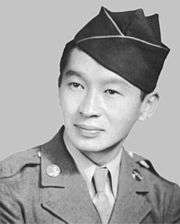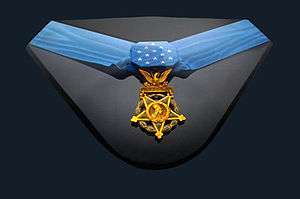Masato Nakae
| Masato Nakae | |
|---|---|
  | |
| Born |
December 20, 1917 Lihue, Hawaii |
| Died | September 4, 1998 (aged 80) |
| Allegiance | United States of America |
| Service/branch | United States Army |
| Years of service | 1942 - 1945 |
| Rank | Private First Class |
| Unit | 100th Infantry Battalion |
| Battles/wars | World War II |
| Awards |
Medal of Honor Purple Heart |
Masato Nakae (December 20, 1917 – September 4, 1998) was a United States Army soldier.[1] He is best known for receiving the Medal of Honor because of his actions in World War II.[2]
Early life
Nakae was born in Hawaii to Japanese immigrant parents. He is a Nisei, which means that he is a second generation Japanese-American.[1]
Soldier
Two months after the Japanese attack on Pearl Harbor, Nakae joined the US Army in February 1942.[3]
Nakae volunteered to be part of the all-Nisei 100th Infantry Battalion.[4] This army unit was mostly made up of Japanese Americans from Hawaii and the mainland.[5]
For his actions in August 1944, he was awarded the Distinguished Service Cross.[6] This award was upgraded to the Medal of Honor after Congress directed the Secretary of the Army to review all awards of the DSC to Americans of Japanese and Pacific Islands descent to determine if racial bias had influenced the awards process. Nakae was one of 22 Americans of Japanese descent who received the Medal of Honor on June 21, 2000 (about two years after his death) by President Bill Clinton.
Medal of Honor citation
The President of the United States of America, authorized by Act of Congress, March 3, 1963, has awarded in the name of The Congress the Medal of Honor to
MASATO NAKAE
UNITED STATES ARMY
for conspicuous gallantry and intrepidity at the risk of his life above and beyond the call of duty:
Private Masato Nakae distinguished himself by extraordinary heroism in action on August 19, 1944, near Pisa, Italy. When his submachine gun was damaged by a shell fragment during a fierce attack by a superior enemy force, Private Nakae quickly picked up his wounded comrade’s M-1 rifle and fired rifle grenades at the steadily advancing enemy. As the hostile force continued to close in on his position, Private Nakae threw six grenades and forced them to withdraw. During a concentrated enemy mortar barrage that preceded the next assault by the enemy force, a mortar shell fragment seriously wounded Private Nakae. Despite his injury, he refused to surrender his position and continued firing at the advancing enemy. By inflicting heavy casualties on the enemy force, he finally succeeded in breaking up the attack and caused the enemy to withdraw. Private Nakae’s extraordinary heroism and devotion to duty are in keeping with the highest traditions of military service and reflect great credit on him, his unit, and the United States Army.
[7]
See also
References
- 1 2 Vachon, Duane. "A Silent Hero -- PFC Masato Nakae, U.S. Army, WWII, Medal of Honor, (1917-1998)," Hawaii Reporter. May 19, 2012; retrieved 2012-12-7.
- ↑ US Army Center of Military History, "Medal of Honor Recipients, World War II (M-S)"; retrieved 2012-12-7.
- ↑ U.S. National Archives and Records Administration (NARA), WWII Army Enlistment Record #30102831 (Nakae, Masato); retrieved 2012-12-7.
- ↑ Go for Broke National Education Center, "Medal of Honor Recipient Private Masato Nakae"; retrieved 2012-12-7.
- ↑ "100th Battalion, 442nd Infantry" at Global Security.org; retrieved 2012-12-7.
- ↑ "21 Asian American World War II Vets to Get Medal of Honor" at University of Hawaii Digital History; retrieved 2012-12-7.
- ↑ Gomez-Granger, Julissa. (2008). Medal of Honor Recipients: 1979-2008, "Masato, Nakae," p. 14 [PDF 18 of 44]; retrieved 2012-12-7.